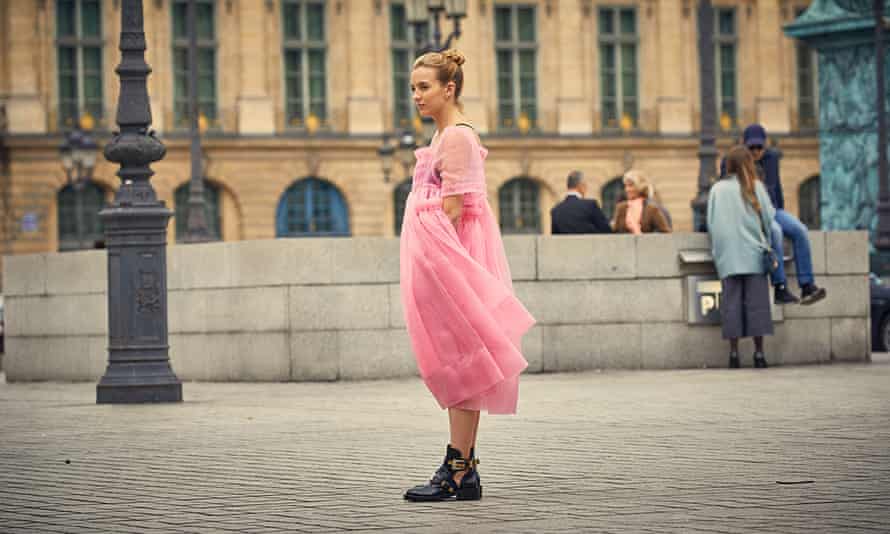
Over the last two years, most of us have experienced the sting of a party cancellation – from weddings and galas to school formals. There was a period when crowded dancefloors and uncomfortably high heels felt like a thing of the past.
Happily, it’s 2022, and we are – hopefully – post-lockdowns and limits on gatherings. To celebrate, well, the return of celebrations, here is some expert advice on the special care everything from tulle, to beading, to lace requires.
Rules for the dancefloor
Almost everyone I know still has some pent-up lockdown energy to expend and while a dancefloor is undeniably a good place to do this, try to keep half an eye on the wellbeing of your outfit.
According to Howard Duffy, a technical officer at the Drycleaning Institute of Australia, “sensibility is key”. He says “spilt drinks on a venue’s floor can lead to a stained or black hem,” which can be particularly difficult to remove, “especially on more fragile fabrics”.
The dancefloor can also be a hazardous place for drink spills that land on shirts or tops. If this happens, he says to dry spot clean the stain to contain it, without wetting or rubbing the fabric. He warns that using water to spot clean an oil stain on a delicate fabric can set the stain and leave a spotting mark – so grab a napkin or paper towel, and gently blot at the stain instead.
Be precise with stains
A good specialist dry cleaner will do a thorough inspection of any garment when it is dropped off, and ask you to explain what each stain is from. This is because liquids react differently on different fabrics – for instance, the detergent required to remove oil on silk will be different from the one that gets rid of wine on cotton.
Sign up to receive Guardian Australia’s weekend culture and lifestyle email.
Ellina Sun, a logistics supervisor at fashion rental company Glam Corner, says to “make it easier for the dry cleaner to remove [the stain] using the correct method”, you should be very detailed about what type of stain they are dealing with.
It’s wise to also mention any previous washing and cleaning methods the garment has gone through, so the dry cleaner understands the wear of the fabric, and if it is possible to remove the stain.
When looking for a specialty dry cleaner, be sure to do your research. Duffy says to pay attention to reviews and whether or not the dry cleaner is part of an industry association.
Sequins and sparkles
If you find that beads or sequins are coming loose over the course of a night out, do your best to collect them and store them somewhere safe so a seamstress can sew them back on later.
When you get home, garments covered in sparkling beads or diamantes can pose a particular dilemma when laundering, even for dry cleaners.
Sun recommends paying attention to the care label to see if the garment can be spot cleaned or given a light hand wash. Whether you’re spot cleaning or washing the whole garment, Sun says, “please don’t scrub, as this can loosen the beading or sequins”.
While the dry cleaner is usually a safe bet, if the garment was insufficiently tested by the manufacturer, Duffy says there is a risk that plastic beading is solvent soluble – meaning it will melt during the cleaning process. He suggests removing any beading and getting someone to re-sew it after cleaning if you are particularly concerned about this.
Tulle
Since tulle is a fine mesh fabric, it’s very easily ripped or snagged, which is something to keep in mind when wearing it and choosing things like accessories (or places to sit).

According to Duffy, dry cleaners see a lot of long tulle dresses with heel holes through the hem. Jewellery can be particularly hazardous for tulle too, so be aware of any rings or bracelets that might catch.
Tulle can be made of either natural or synthetic fibres, so you should check the care label to see if you should wash or dry clean it.
Sun says if you are going to put it in the washing machine, make sure you use a garment bag. If there is a stain on it, she says, “it’s best to soak it in liquid detergent and avoid scrubbing”.
Embroidery
The main concern when caring for embroidery is that if it gets wet, the colour from the embroidery could bleed into the main fabric, so it’s important to read the care instructions before putting anything embroidered in the wash.
Pay attention to whether the embroidery was done by machine or hand, says Sun, and note the composition of the base fabric to determine if you can wash it at home. Embroidery on a delicate fabric like tulle or silk should be taken to the dry cleaners, but sturdy embroidery on cotton should be OK to hand or machine wash.
While wearing anything embroidered, Sun says, “be mindful not to get the embroidery caught on anything, as this will loosen the threads and change the look of the design”. If this does happen, a specialty seamstress might be able to fix it later.
Pleats
Unfortunately, pleats in garments will often soften and fall out after a few wears. Duffy laments for a time when permanent pleating was more common, since it could withstand both wet and dry cleaning.
In the absence of this, pleats can be pressed back in. Before doing this, Sun says you should make sure the garment is clean and all stains have been removed, otherwise you will risk setting them in.
If you are brave enough to try it at home, Duffy says to use a “low setting on the iron and iron on the reverse side, or use an ironing cloth”.
While you can try to re-pleat a garment using an iron at home, Sun says it can be difficult to replicate a professional result. At this point, she recommends “going to the dry cleaners to get it pressed”.

Lace
Although once upon a time, lace was woven by hand, now, according to Duffy, “most lace today is a polyester base”. That means it can usually be washed or dry cleaned depending on the care instructions.
If the lace is particularly delicate, Sun recommends using a garment bag when washing. Once again, she warns against scrubbing, as this may damage or change the lace’s pattern.
Don’t be lazy
Mostly, special occasion garments are only worn a few times a year, so storing them is particularly important. Sun says to make sure the garment is clean and free from smells or stains before you put it away, as sweat stains and smells can get worse over time. It’s equally important to ensure any damage has been repaired, as loose threads and tears can also degrade further when a garment is tucked away.
To make sure your occasion wear “is safe from dust and moths” Sun recommends keeping it in “a garment bag or sealed box”.
Finally, but most importantly: “Don’t forget about it! It is good to check the garment every few months just to see how it is holding up.”



